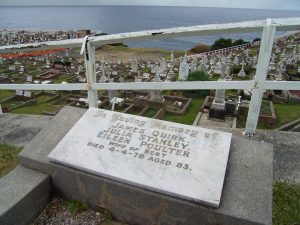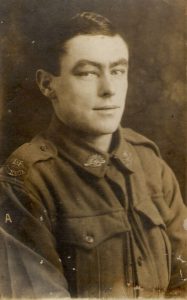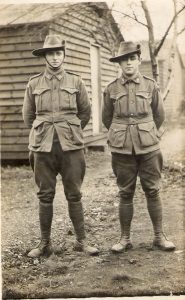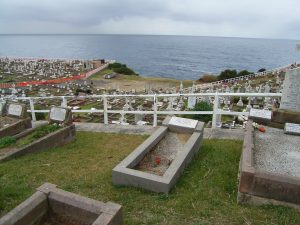17 minute read
In the late 1980s, my great Uncle Bertie led me up the road from his childhood home in Clovelly, to the magnificent Waverley cemetery. Perched high on a cliff top, overlooking the azure waters of the Pacific Ocean, his parents and maternal grandparents lay in an enviable prime piece of Sydney real estate. Bertie’s grandmother Julia Walsh (later Quirk and Stanley) was a proud Irishwoman whose own children instilled an Irish sense of proud that still lingers in her descendants today. There are no known photographs of Julia in existence, so we do not know what she looked like or how she held herself. Similarly, there are no courtroom transcripts or personal letters to illuminate her character. We must find it in the small anecdotal snippets handed down through her descendants and in the facts of her life, to imagine who she was. After years of research, I am finally able to bring you Julia’s story.

Killarney, southwest Ireland. A land of rolling green hills and Celtic folk music where Julia was born on the 14th September 1858 in the small village of Glenflesk, ten kilometres south of Killarney. Julia’s parents were Catholic, Michael Walsh and Bridget Mason, who married on the 7th February 1837. Julia was one of ten children, her siblings being Maurice, John, Michael, Mary, Catherine, James, Ellen, Johanna and Margaret. It is not known what Michael Walsh did for a living but many Catholic families lived as tenant farmers on land only just big enough to support the growth of potatoes and not much else. Michael and Bridget Walsh raised their children through the toughest time in Ireland’s history; the Irish Potato Famine, or the Great Hunger, which began in 1845 and did not abate for seven long years. Potato crops across the country were blighted with a disease which turned the vegetables to mush. The failure of multiple seasons of crops caused enormous hardship. Workhouses were established to house the poor who could no longer feed and clothe themselves and for the orphans left behind when their parents died. We know that as Julia was born some years after the famine abated, her parents survived but little else is known. At least a million Irish migrated to the United States, Canada, Britain or Australia to escape their poverty, so it’s possible Walsh descendants live around the world today. It is believed at least three of them sailed to Australia.
By the time Julia was in her early teens she would have gone to work as a domestic servant, which is where we first see her in the records. In 1882, Julia was recorded as living in Green Lane, New Street, Killarney and stated her age as 21 years old for the immigration authorities, perhaps worried that stating her real age of 24 would disadvantage her. Julia’s sister Ellen had already migrated to Sydney with her husband John Casey and was established enough to sponsor her younger sister to Sydney. Another sister Catherine had made her way to Melbourne. Julia sailed from Killarney to Plymouth where she boarded the ship that would mark a significant change in her life. The Ellora left Plymouth on the 9th February 1883 with 353 people on board, with 137 single men and 73 single women, including Julia, as well as married couples and children. Six weeks into the journey, off the coast of southern Africa, the ship encountered a storm which broke waves over the decks, smashing two lifeboats and destroying two water-closets (toilets). The storm continued for some 24 hours, terrifying the passengers. The rest of the journey was blessed with relatively calm seas, with the ship taking three months to reach Sydney, with a loss of five souls to illness and two births. Arriving on the 11th June 1883, mid-winter in Sydney, Julia would have been surprised by the mild climate, something akin to spring back in southern Ireland. The ship docked at Neutral Bay, across the harbour from the main port and Julia took in the views of her new home, the stunning sight of a busy harbour and growing city. Ellen Casey would have met her off the ship, a welcoming face after the long journey.
Domestic servants had always been in short supply in Sydney and so Julia was soon employed in this capacity. One of the few stories handed down the generations about Julia is how she worked as a domestic servant in well-to-do Sydney homes, polishing their silver, cleaning their houses, washing and ironing their clothes, and whatever other domestic duties were required. The hours were long and the work back breaking. Add to this the low wages and Julia soon sought escape, in the most common way of the time, through marriage. By early 1885, some eighteen months after arrival in Sydney, Julia had met young James Quirk, a locally-born labourer of Irish parentage. James was 23 years old whilst Julia was now 27. On the 30th December 1885, Julia gave birth to their first child, Ernest James (known as Mick), at the home they shared, Elizabeth Cottage, in Vernon St, Woollahra. The birth certificate states that the couple had married (conveniently) in March of the same year. In fact, James and Julia did not wed until August of 1887, at the Church of St Matthias in Paddington, under the rights of the Church of England, despite the fact the couple were both Catholic. In the meantime, they had also had a baby daughter, called Margaret, who was born in April 1887. She lived for only six hours, having been born prematurely. She was buried in Waverley cemetery. Two more children were born following their marriage, William John (known as Jack) in 1888 and Mabel, born in 1890.
The Quirk family lived in Sydney’s eastern suburbs, in Woollahra, Paddington and Waverley, then very working-class areas full of small worker’s cottages and terrace houses. If life for the young family had been tough up to now, living on a small labourer’s wage, it was small in comparison to the hardships to come. The first sign of trouble within the marriage came in 1891, when in April of that year, James was charged by Julia with deserting her. The Evening News, a Sydney newspaper, reported the court case, stating that James had left his wife without means of support. By the time they got to court, James and Julia had (as the newspaper termed it) ‘made up’ and the case was dismissed. In January the following year, Julia was forced to place 6-year-old Mick, 4-year-old Jack and 16-month-old Mabel into the Benevolent Asylum, a Sydney charitable institute (located near the current day Central Station), that took in women and children who had fallen on hard times. The admission book stated that James Quirk was ‘locked up and mother destitute and has an infant.’ That infant was Maurice. The three older children stayed in the asylum from the 16th to the 25th January 1892 and were then returned to their mother. Searching the gaol records and police gazette, I found James Quirk was arrested on the 16th January 1892 for ‘fraudulently removing his furniture to evade payment of rent to William Rush’. James was later released as no prosecution went ahead. Evading rent payments in this way was not an uncommon practice at the time and indeed was employed by later members of the family when the Great Depression hit.
Intrigued by this period of Julia’s life, I investigated further by searching more of the original books of the Benevolent Asylum (kept at the State Library in Sydney). I found two very curious notes from the outdoor relief book of the asylum, dated 13th October and 3rd November 1891. The notes stated that Julia Quirk said her ‘husband was unemployed and there were three children in the family’. It went on to note that ‘Mrs Quirk, near her confinement and having three children to care for, was granted (relief). Her husband, a Chinese, was sick.’ This could have been an error on the part of the documenter, or now more likely, Julia may have sought refuge with a Chinese man whilst separated from husband James. We know James Quirk was not Chinese, but of Irish parentage. Baby Maurice was born late December 1891 or early January 1892 (as admission records indicate), and Julia had placed the notice of desertion in April 1891. Further adding to this mystery, there are two surviving photographs of Maurice, the child in question, taken during his service in WW1. Maurice had dark features, and unusually shaped eyes for a Caucasian man. He was also quite a small man, certainly in comparison to his mate Bluey, whom he is standing next to in one photograph. Chinese men were generally smaller in stature than European men in the 19th century. We have a further clue contained in the WW1 enlistment records of the three Quirk brothers. Both Jack and Mick were 5ft 7 to 5ft 10 inches tall according to various documents. Maurice was just 5ft 3 inches, quite a height difference. Jack and Mick again were both listed as having fair complexions, blue eyes and light brown hair. Maurice on the other hand, had a dark complexion, brown eyes and dark hair. He was, in many ways, the complete opposite of his older brothers. Could Maurice have been the illegitimate son of Julia Quirk and a Chinese man? DNA testing would today have given us the answer, however Maurice was killed in France in 1918, leaving no descendants. There is also the question of his nickname, Modge, and its origin. The term Modge is an old Midland English word meaning to do shoddily or make a mess of.
My initial thoughts when I found the entry about the Chinese man were that perhaps an error had been made in the Asylum books, but upon delving into the possibility that it may be true, I came across an article confirming it was more than possible. I knew from doing research on the Earl Grey Irish famine orphans that some women had cohabitated with Chinese men, but it would appear the practice in Sydney was more widespread than I imagined. By 1881 there were 1300 Chinese men living in Sydney. Most had come to Australia alone. An 1891 Parliamentary Commission found that many abused women found refuge with Chinese men who treated them better than their husbands. These women would have been ‘on the streets of Sydney if they were not the mistresses of industrious Chinamen.’ One woman explained that she and others like her ‘would sooner live with a Chinaman than a white man. The Chinamen know how to treat a woman!’ It was also noted that the Chinese men’s homes were ‘clean and comfortable’ and there was ‘always plenty to eat and drink.’ Destitute women living in Sydney in the late 19th century did what they could to survive and this was just one way they did so. As for Julia, we have a single note in an asylum record and a photograph of her son to suggest she may have sought refuge with a Chinese man to save herself and her family from the ravages of starvation, a scenario Julia would have gone to great lengths to avoid, given her background. Whatever the case, it appears to have been a short-lived survival measure, for James came back to her and they were reconciled once more.


Now with four children to raise, and a husband who liked to go roaming, Julia was left in a precarious position. By 1893, the great economic depression of the 1890s had begun to bite and James could easily have been in and out of work for extended periods. In late 1893 the Quirks were living at number 93 Grafton St in Woollahra and it was here that Julia experienced another frightening experience, when she was assaulted by a man unknown to her, in her own home. The Evening News ran the story of the 45-year-old assailant named Andrew Copeland who knocked on Julia’s front door. One of the children answered and was asked if their father was home, to which they replied ‘No’. Julia then appeared at the door and was asked again if her husband was at home and when she replied no as well. Copeland replied, ‘that will be all the better.’ He pushed his way into the home where he threw Julia on the ground and made improper movements towards her. Julia’s children, then aged 8, 5, 3 and 1, clung to their mother and screamed loudly enough to entice Copeland to flee the home. The police were called and a search found Copeland in the house next door. On the way to the station, he punched the arresting officer in the face. Copeland, a ship’s cook, received a six-month sentence for the assault on Julia and a further three months for assaulting the police officer. The protectiveness of her children saved Julia from any serious harm but no doubt the incident shook her confidence.
The following year, in July 1894, Julia and James welcomed one last child to their family, little Eileen, my great grandmother. It was not long however, before family life was torn apart once more. In December 1895, Julia was admitted again to the Benevolent Asylum with her five children; Mick now aged 10, Jack aged 7, Mabel aged 5, Maurice aged 4 and Eileen aged 18 months, where they stayed for a month. The notes stated ‘married, destitute, emergency.’ Upon their release on the 10th January 1896, Julia and baby Eileen were allowed to go home, but the four other children were boarded out (a common practice at the time, akin to the modern day foster system). This story had been handed down to my Aunty Joyce (Eileen’s daughter), so this came as no surprise to me. It is not known how long the children were boarded out for, but it does appear to have been brief. The Benevolent Asylum and the boarding out system were Julia’s safety nets, in a city where she had only a sister to rely upon. James’s father lived just a few minutes away but it is not known if he, or James’ siblings were able to provide support. In a dozen short years, Julia’s life had gone from single rural Irish lass to a destitute married woman with five small children in a busy city.
But the torment for Julia did not end there. Almost four years later, just after Christmas 1899, Julia once again applied for and was granted a stay at the Benevolent Asylum. She was by now 41 years old and destitute, with her husband James unable to support the family again. Julia had four of her children with her, 11 ½ year old Jack, 9 ½ year old Mabel, 7-year-old Maurice and 5-year-old Eileen. Mick, the eldest at 14, was not admitted to the asylum. Jack later absconded, perhaps to be with his older brother. A week-long stay was enough this time to help Julia get on her feet and the family was discharged on the 6th January 1900. It may have been that Julia looked to a new century with hope. It was not to be as James and Julia’s relationship hit rock bottom. In the list of cases from the police courts reported on by the Sydney Morning Herald on Friday 9th March 1900, the following was the last mentioned. ‘Unlawful assault: At the Paddington Police Court yesterday, before Mr E H Wilshire, S.M; James Quirk was charged with unlawfully assaulting one Julia Quirk, his wife, in a violent manner, on March 5, for which he was ordered to pay the sum of two pounds with costs 5 shillings and six pence or 21 days gaol.’ James’s gaoling would not have eased the tensions at home nor helped financially. There were no further reports of assault however so Julia’s bravery to have him charged may have prevented any more abuse. We shall never know for sure. Whatever the case, Julia’s torment would eventually come to an end, sooner than she could have predicted. By 1904, James’ diseased lungs had prevented him from working altogether and he was admitted to the Liverpool asylum, a place for destitute and sick men, where he died that year. The Cumberland Argus reported his death with the headline, ‘A pathetic occurrence!’ James and Julia had been standing and listening to the Burwood band playing the national anthem when suddenly James fell backwards. Spewing blood from his mouth, James was ‘caught by his wife in her arms and expired immediately.’ He was 42 years old and left behind his wife and five children, who were aged between 19 and 10 years old.
With just two of her children old enough to work to support the family, Julia again used her tenacity to overcome her misfortune. Help would arrive in the form of James Stanley, a friend of her three sons, who stepped up to provide for the family. James and Julia were married on the 11th May 1905 in St Patrick’s Catholic Church. The marriage certificate stated that Julia was 35 years old and James was 25 years old. In fact, James was about 22 years of age, whilst Julia was already 47 years old. Whether a marriage of convenience or a love match, it now provided Julia with some much-deserved peace and support. The marriage lasted nine years, ending upon Julia’s death on the 16th January 1914, aged 57. Her funeral procession left her home at 2 James St, Woollahra, a day after her death. She was buried in Waverley cemetery, with her husband James Quirk. Her daughter Eileen and son-in-law Bert would later be buried there too. It was a fitting last resting place for an Irish lass to view the sea from which she sailed all those years ago.
A year after she died, Julia’s family paid tribute to her in the Sydney Morning Herald; ‘In sad but loving memory of my dear wife and our dear mother, Julia Stanley, who departed this life January 16, 1914. Lord, have mercy on her soul. Inserted by her husband James Stanley, and family Ernest, John, Mabel, Maurice and Eileen Quirk.’ Jack had already enlisted in the army by this time and Mick, Maurice and husband James would follow soon after, leaving the two girls, Mabel and Eileen to endure their long-awaited return from war. Jack, Mick and James all did return home, but Maurice did not. A blessing perhaps, that Julia had passed before bearing witness to, and enduring the pain, of losing a son. Julia’s daughter, my great grandmother Eileen would grow up with a strong sense of her Irish identity, despite the fact she lost both her parents by the time she was just 20. Julia instilled a sense of Irish pride in her children who passed it on to later generations, where we that are still here, also proudly claim it. I’d like to think, after enduring so much heartache and struggle, that honouring our Irish heritage, would make Julia smile.

